Koalas typically inhabit open eucalypt woodlands, and the leaves of these trees make up most of their diet. Because this eucalypt diet has limited nutritional and caloric content, koalas are largely sedentary and sleep up to 20 hours a day. They are asocial animals, and bonding exists only between mothers and dependent offspring. Adult males communicate with loud bellows that intimidate rivals and attract mates. Males mark their presence with secretions from scent glands located on their chests. Being marsupials, koalas give birth to underdeveloped young that crawl into their mothers' pouches, where they stay for the first six to seven months of their lives. These young koalas, known as joeys, are fully weaned around a year old. Koalas have few natural predators and parasites, but are threatened by various pathogens, such as Chlamydiaceae bacteria and the koala retrovirus, as well as by bushfires and droughts.
Koalas were hunted by indigenous Australians and depicted in myths and cave art for millennia. The first recorded encounter between a European and a koala was in 1798, and an image of the animal was published in 1810 by naturalist George Perry. Botanist Robert Brown wrote the first detailed scientific description of the koala in 1814, although his work remained unpublished for 180 years. Popular artist John Gould illustrated and described the koala, introducing the species to the general British public. Further details about the animal's biology were revealed in the 19th century by several English scientists. Because of its distinctive appearance, the koala is recognised worldwide as a symbol of Australia. Koalas are listed as Vulnerable by the International Union for Conservation of Nature.[1] The Australian government similarly lists specific populations in Queensland and New South Wales as Vulnerable.[4] The animal was hunted heavily in the early 20th century for its fur, and large-scale cullings in Queensland resulted in a public outcry that initiated a movement to protect the species. Sanctuaries were established, and translocation efforts moved to new regions koalas whose habitat had become fragmented or reduced. The biggest threat to their existence is habitat destruction caused by agriculture and urbanisation.

Etymology
The word koala comes from the Dharug gula. Although the vowel 'u' was originally written in the English orthography as "oo" (in spellings such as coola or koolah), it was changed to "oa", possibly in error.[5] Because of the koala's supposed resemblance to a bear, it was often miscalled the koala bear, particularly by early settlers.[6] The generic name, Phascolarctos, is derived from the Greek words phaskolos "pouch" and arktos "bear". The specific name, cinereus, is Latin for "ash coloured".[7]Taxonomy and evolution
| Phylogeny of Diprotodontia, (with outgroup)[8] |
The koala is classified with wombats (family Vombatidae) and several extinct families (including marsupial tapirs, marsupial lions and giant wombats) in the suborder Vombatiformes within the order Diprotodontia.[11] The Vombatiformes are a sister group to a clade that includes macropods (kangaroos and wallabies) and possums.[12] The ancestors of vombatiforms were likely arboreal,[8] and the koala's lineage was possibly the first to branch off around 40 million years ago during the Eocene.[13]
Reconstructions of the ancient koalas Nimiokoala (larger), and Litokoala (smaller), from the Miocene Riversleigh Fauna
During the Pliocene and Pleistocene, when Australia experienced changes in climate and vegetation, koala species grew larger.[15] P. cinereus may have emerged as a dwarf form of the giant koala (P. stirtoni). The reduction in the size of large mammals has been seen as a common phenomenon worldwide during the late Pleistocene, and several Australian mammals, such as the agile wallaby, are traditionally believed to have resulted from this dwarfing. A 2008 study questions this hypothesis, noting that P. cinereus and P. stirtoni were sympatric during the middle to late Pleistocene, and possibly as early as the Pliocene.[18] The fossil record of the modern koala extends back at least to the middle Pleistocene.[19]
Genetics and variations
Traditionally, three distinct subspecies have been recognised: the Queensland koala (P. c. adustus, Thomas 1923), the New South Wales koala (P. c. cinereus, Goldfuss 1817), and the Victorian koala (P. c. victor, Troughton 1935). These forms are distinguished by pelage colour and thickness, body size, and skull shape. The Queensland koala is the smallest of the three, with shorter, silver fur and a shorter skull. The Victorian koala is the largest, with shaggier, brown fur and a wider skull.[20][21] The boundaries of these variations are based on state borders, and their status as subspecies is disputed. A 1999 genetic study suggests that the variations represent differentiated populations with limited gene flow between them, and that the three subspecies comprise a single evolutionarily significant unit.[21] Other studies have found that koala populations have high levels of inbreeding and low genetic variation.[22][23] Such low genetic diversity may have been a characteristic of koala populations since the late Pleistocene.[24] Rivers and roads have been shown to limit gene flow and contribute to the genetic differentiation of southeast Queensland populations.[25] In April 2013, scientists from the Australian Museum and Queensland University of Technology announced they had fully sequenced the koala genome.[26]Description
Scratching and grooming
The pelage of the koala is thicker and longer on the back, and shorter on the belly. The ears have thick fur on both the inside and outside.[29] The back fur colour varies from light grey to chocolate brown.[27] The belly fur is whitish; on the rump it is dappled whitish, and darker at the back.[28] The koala has the most effective insulating back fur of any marsupial and is highly resilient to wind and rain, while the belly fur can reflect solar radiation.[34] The koala's curved, sharp claws are well adapted for climbing trees. The large forepaws have two opposable digits (the first and second, which are opposable to the other three) that allow them to grasp small branches. On the hindpaws, the second and third digits are fused, a typical condition for members of the Diprotodontia, and the attached claws (which are still separate) are used for grooming.[35] As in humans and other primates, koalas have friction ridges on their paws.[36] The animal has a sturdy skeleton and a short, muscular upper body with proportionately long upper limbs that contribute to its climbing and grasping abilities. Additional climbing strength is achieved with thigh muscles that attach to the shinbone lower than other animals.[37] The koala has a cartilaginous pad at the end of the spine that may make it more comfortable when it perches in the fork of a tree.[33]
Mounted skeleton
The koala has several adaptations for its eucalypt diet, which is of low nutritive value, of high toxicity, and high in dietary fibre.[43] The animal's dentition consists of the incisors and cheek teeth (a single premolar and four molars on each jaw), which are separated by a large gap (a characteristic feature of herbivorous mammals). The incisors are used for grasping leaves, which are then passed to the premolars to be snipped at the petiole before being passed to the highly cusped molars, where they are shredded into small pieces.[44] Koalas may also store food in their cheek pouches before it is ready to be chewed.[45] The partially worn molars of middle-aged koalas are optimal for breaking the leaves into small particles, resulting in more efficient stomach digestion and nutrient absorption in the small intestine,[46] which digests the eucalyptus leaves to provide most of the animal's energy.[44] A koala sometimes regurgitates the food into the mouth to be chewed a second time.[47]
Unlike kangaroos and eucalyptus-eating possums, koalas are hindgut fermenters, and their digestive retention can last for up to 100 hours in the wild, or up to 200 hours in captivity.[44] This is made possible by the extraordinary length of their caecum—200 cm (80 in) long and 10 cm (4 in) in diameter—the largest proportionally of any animal.[48] Koalas can select which food particles to retain for longer fermentation and which to pass through. Large particles typically pass through more quickly, as they would take more time to digest.[44] While the hindgut is proportionally larger in the koala than in other herbivores, only 10% of the animal's energy is obtained from fermentation. Since the koala gains a low amount of energy from its diet, its metabolic rate is half that of a typical mammal,[43] although this can vary between seasons and sexes.[44] The koala conserves water by passing relatively dry faecal pellets high in undigested fibre, and by storing water in the caecum.[46]
Ecology and behaviour
Walking on ground
In Queensland, koalas are unevenly distributed and uncommon except in the southeast, where they are numerous. In New South Wales, they are abundant only in Pilliga, while in Victoria they are common nearly everywhere. In South Australia, koalas were extirpated by 1920 and subsequently reintroduced.[1] Koalas can be found in habitats ranging from relatively open forests to woodlands, and in climates ranging from tropical to cool temperate.[29] In semi-arid climates, they prefer riparian habitats, where nearby streams and creeks provide refuge during times of drought and extreme heat.[51]
Foraging and activities
Foraging
Because they get so little energy from their diet, koalas must limit their energy use and sleep 20 hours a day;[60] only 4 hours a day are spent in active movement.[61] They are predominantly active at night and spend most of their waking hours feeding. They typically eat and sleep in the same tree, possibly for as long as a day.[62] On very hot days, a koala may climb down to the coolest part of the tree which is cooler than the surrounding air. The koala hugs the tree to lose heat without panting.[63][64] On warm days, a koala may rest with its back against a branch or lie on its stomach or back with its limbs dangling.[60] During cold, wet periods, it curls itself into a tight ball to conserve energy.[62] On windy days, a koala finds a lower, thicker branch on which to rest. While it spends most of the time in the tree, the animal descends to the ground to move to another tree, walking on all fours.[60] The koala usually grooms itself with its hindpaws, but sometimes uses its forepaws or mouth.[65]
Social spacing
A bellowing male in the Lone Pine Koala Sanctuary
Adult males communicate with loud bellows—low pitched sounds that consist of snore-like inhalations and resonant exhalations that sound like growls.[72] These sounds are thought to be generated by unique vocal organs found in koalas.[42] Because of their low frequency, these bellows can travel far through air and vegetation.[73] Koalas may bellow at any time of the year, particularly during the breeding season, when it serves to attract females and possibly intimidate other males.[74] They also bellow to advertise their presence to their neighbours when they enter a new tree.[73] These sounds signal the male's actual body size, as well as exaggerate it;[75] females pay more attention to bellows that originate from larger males.[76] Female koalas bellow, though more softly, in addition to making snarls, wails, and screams. These calls are produced when in distress and when making defensive threats.[72] Young koalas squeak when in distress. As they get older, the squeak develops into a "squawk" produced both when in distress and to show aggression. When another individual climbs over it, a koala makes a low grunt with its mouth closed. Koalas make numerous facial expressions. When snarling, wailing, or squawking, the animal curls the upper lip and points its ears forward. During screams, the lips retract and the ears are drawn back. Females bring their lips forward and raise their ears when agitated.[77]
Agonistic behaviour typically consists of squabbles between individuals climbing over or passing each other. This occasionally involves biting. Males that are strangers may wrestle, chase, and bite each other.[78] In extreme situations, a male may try to displace a smaller rival from a tree. This involves the larger aggressor climbing up and attempting to corner the victim, which tries either to rush past him and climb down or to move to the end of a branch. The aggressor attacks by grasping the target by the shoulders and repeatedly biting him. Once the weaker individual is driven away, the victor bellows and marks the tree.[79] Pregnant and lactating females are particularly aggressive and attack individuals that come too close.[78] In general, however, koalas tend to avoid energy-wasting aggressive behaviour.[68]
Reproduction and development
Mother with joey on back
The koala's gestation period lasts 33–35 days,[82] and a female gives birth to a single joey (although twins occur on occasion). As with all marsupials, the young are born while at the embryonic stage, weighing only 0.5 g (0.02 oz). However, they have relatively well-developed lips, forelimbs, and shoulders, as well as functioning respiratory, digestive, and urinary systems. The joey crawls into its mother's pouch to continue the rest of its development.[83] Unlike most other marsupials, the koala does not clean her pouch.[84]
A female koala has two teats; the joey attaches itself to one of them and suckles for the rest of its pouch life.[83] The koala has one of the lowest milk energy production rates in relation to body size of any mammal. The female makes up for this by lactating for as long as 12 months.[85] At seven weeks of age, the joey's head grows longer and becomes proportionally large, pigmentation begins to develop, and its sex can be determined (the scrotum appears in males and the pouch begins to develop in females). At 13 weeks, the joey weighs around 50 g (1.8 oz) and its head has doubled in size. The eyes begin to open and fine fur grows on the forehead, nape, shoulders, and arms. At 26 weeks, the fully furred animal resembles an adult, and begins to poke its head out of the pouch.[86]
As the young koala approaches six months, the mother begins to prepare it for its eucalyptus diet by predigesting the leaves, producing a faecal pap that the joey eats from her cloacum. The pap is quite different in composition from regular faeces, resembling instead the contents of the caecum, which has a high concentration of bacteria. Eaten for about a month, the pap provides a supplementary source of protein at a transition time from a milk to a leaf diet.[87] The joey fully emerges from the pouch for the first time at six or seven months of age, when it weighs 300–500 g (11–18 oz). It explores its new surroundings cautiously, clinging to its mother for support. By nine months, it weighs over 1 kg (2.2 lb) and develops its adult fur colour. Having permanently left the pouch, it rides on its mother's back for transportation, learning to climb by grasping branches.[88] Gradually, it spends more time away from its mother, and at 12 months it is fully weaned, weighing around 2.5 kg (5.5 lb). When the mother becomes pregnant again, her bond with her previous offspring is permanently severed. Newly weaned young are encouraged to disperse by their mothers' aggressive behaviour towards them.[89]
A young joey, preserved at Port Macquarie Koala Hospital
Health and mortality
Koalas may live from 13 to 18 years in the wild. While female koalas usually live this long, males may die sooner because of their more hazardous lives.[92] Koalas usually survive falls from trees and immediately climb back up, but injuries and deaths from falls do occur, particularly in inexperienced young and fighting males.[93] Around six years of age, the koala's chewing teeth begin to wear down and their chewing efficiency decreases. Eventually, the cusps disappear completely and the animal will die of starvation.[94]Koalas have few predators; dingos and large pythons may prey on them, while birds of prey (such as powerful owls and wedge-tailed eagles) are threats to young. They are generally not subject to external parasites, other than ticks in coastal areas. Koalas may also suffer mange from the mite Sarcoptes scabiei, and skin ulcers from the bacterium Mycobacterium ulcerans, but neither is common. Internal parasites are few and largely harmless.[93] These include the tapeworm Bertiella obesa, commonly found in the intestine, and the nematodes Marsupostrongylus longilarvatus and Durikainema phascolarcti, which are infrequently found in the lungs.[95] In a three-year study of almost 600 koalas admitted to the Australian Zoo Wildlife Hospital in Queensland, 73.8% of the animals were infected with at least one species of the parasitic protozoal genus Trypanosoma, the most common of which was T. irwini.[96]
Koalas can be subject to pathogens such as Chlamydiaceae bacteria,[93] which can cause keratoconjunctivitis, urinary tract infection, and reproductive tract infection.[97] Such infections are widespread on the mainland, but absent in some island populations.[98] The koala retrovirus (KoRV) may cause koala immune deficiency syndrome (KIDS) which is similar to AIDS in humans. Prevalence of KoRV in koala populations suggests a trend spreading from the north to the south of Australia. Northern populations are completely infected, while some southern populations (including Kangaroo Island) are free.[99]
The animals are vulnerable to bushfires due to their slow movements and the flammability of eucalypt trees.[100] The koala instinctively seeks refuge in the higher branches, where it is vulnerable to intense heat and flames. Bushfires also fragment the animal's habitat, which restricts their movement and leads to population decline and loss of genetic diversity.[101] Dehydration and overheating can also prove fatal.[102] Consequently, the koala is vulnerable to the effects of climate change. Models of climate change in Australia predict warmer and drier climates, suggesting that the koala's range will shrink in the east and south to more mesic habitats.[103] Droughts also affect the koala's well-being. For example, a severe drought in 1980 caused many Eucalyptus trees to lose their leaves. Subsequently, 63% of the population in southwestern Queensland died, especially young animals that were excluded from prime feeding sites by older, dominant koalas, and recovery of the population was slow.[41] Later, this population declined from an estimated mean population of 59,000 in 1995 to 11,600 in 2009, a reduction attributed largely to hotter and drier conditions resulting from droughts in most years between 2002 and 2007.[104] Another predicted negative outcome of climate change is the effect of elevations in atmospheric CO2 levels on the koala's food supply: increases in CO2 cause Eucalyptus trees to reduce protein and increase tannin concentrations in their leaves, reducing the quality of the food source.[105]
Human relations
History
George Perry's illustration in his 1810 Arcana was the first published image of the koala.
Botanist Robert Brown was the first to write a detailed scientific description of the koala in 1814, based on a female specimen captured near what is now Mount Kembla in the Illawarra region of New South Wales. Austrian botanical illustrator Ferdinand Bauer drew the animal's skull, throat, feet, and paws. Brown's work remained unpublished and largely unnoticed, however, as his field books and notes remained in his possession until his death, when they were bequeathed to the British Museum (Natural History) in London. They were not identified until 1994, while Bauer's koala watercolours were not published until 1989.[111] British surgeon Everard Home included details of the koala based on eyewitness accounts of William Paterson, who had befriended Brown and Bauer during their stay in New South Wales.[112] Home, who in 1808 published his report in the journal Philosophical Transactions of the Royal Society,[113] gave the animal the scientific name Didelphis coola.[114]
The first published image of the koala appeared in George Perry's (1810) natural history work Arcana.[115] Perry called it the "New Holland Sloth" on account of its perceived similarities to the Central and South American tree-living mammals of genus Bradypus. His disdain for the koala, evident in his description of the animal, was typical of the prevailing early 19th-century British attitude about the primitiveness and oddity of Australian fauna:[116]
"... the eye is placed like that of the Sloth, very close to the mouth and nose, which gives it a clumsy awkward appearance, and void of elegance in the combination ... they have little either in their character or appearance to interest the Naturalist or Philosopher. As Nature however provides nothing in vain, we may suppose that even these torpid, senseless creatures are wisely intended to fill up one of the great links of the chain of animated nature ...".[117]
Natural history illustrator John Gould popularised the koala with his 1863 work The Mammals of Australia.
The first living koala in Britain arrived in 1881, purchased by the Zoological Society of London. As related by prosecutor to the society, William Alexander Forbes, the animal suffered an accidental demise when the heavy lid of a washstand fell on it and it was unable to free itself. Forbes used the opportunity to dissect the fresh female specimen, thus was able to provide explicit anatomical details on the female reproductive system, the brain, and the liver—parts not previously described by Owen, who had access only to preserved specimens.[123] Scottish embryologist William Caldwell—well known in scientific circles for determining the reproductive mechanism of the platypus—described the uterine development of the koala in 1884,[124] and used the new information to convincingly place the koala and the monotremes into an evolutionary time frame.[125]
Prince Henry, Duke of Gloucester, visited the Koala Park Sanctuary in Sydney in 1934[126] and was "intensely interested in the bears". His photograph, with Noel Burnet, the founder of the park, and a koala, appeared in The Sydney Morning Herald. After World War II, when tourism to Australia increased and the animals were exported to zoos overseas, the koala's international popularity rose. Several political leaders and members of royal families had their pictures taken with koalas, including Queen Elizabeth II, Prince Harry, Crown Prince Naruhito, Crown Princess Masako, Pope John Paul II, US President Bill Clinton, Soviet premier Mikhail Gorbachev, South African President Nelson Mandela,[127] Prime Minister Tony Abbott, and Russian President Vladimir Putin.[128]
Cultural significance
The koala is featured in the Dreamtime stories and mythology of indigenous Australians. The Tharawal people believed that the animal helped row the boat that brought them to the continent.[133] Another myth tells of how a tribe killed a koala and used its long intestines to create a bridge for people from other parts of the world. This narrative highlights the koala's status as a game animal and the length of its intestines.[134] Several stories tell of how the koala lost its tail. In one, a kangaroo cuts it off to punish the koala for being lazy and greedy.[135] Tribes in both Queensland and Victoria regarded the koala as a wise animal and sought its advice. Bidjara-speaking people credited the koala for turning barren lands into lush forests.[136] The animal is also depicted in rock carvings, though not as much as some other species.[137]
Early European settlers in Australia considered the koala to be a prowling sloth-like animal with a "fierce and menacing look".[138] At the beginning of the 20th century, the koala's reputation took a more positive turn, largely due to its growing popularity and depiction in several widely circulated children's stories.[139] It is featured in Ethel Pedley's 1899 book Dot and the Kangaroo, in which it is portrayed as the "funny native bear".[138] Artist Norman Lindsay depicted a more anthropomorphic koala in The Bulletin cartoons, starting in 1904. This character also appeared as Bunyip Bluegum in Lindsay's 1918 book The Magic Pudding.[140] Perhaps the most famous fictional koala is Blinky Bill. Created by Dorothy Wall in 1933, the character appeared in several books and has been the subject of films, TV series, merchandise, and a 1986 environmental song by John Williamson.[141] The first Australian stamp featuring a koala was issued by the Commonwealth in 1930.[142] A television ad campaign for Australia's national airline Qantas, starting in 1967 and running for several decades, featured a live koala (voiced by Howard Morris), who complained that too many tourists were coming to Australia and concluded "I hate Qantas".[143] The series has been ranked among the greatest commercials of all time.[144]
The song "Ode to a Koala Bear" appears on the B-side of the 1983 Paul McCartney/Michael Jackson duet single Say Say Say.[141] A koala is the main character in Hanna-Barbera's The Kwicky Koala Show and Nippon Animation's Noozles, both of which were animated cartoons of the early 1980s. Food products shaped like the koala include the Caramello Koala chocolate bar and the bite-sized cookie snack Koala's March. Dadswells Bridge in Victoria features a tourist complex shaped like a giant koala,[127] and the Queensland Reds rugby team has a koala as its mascot.[145] The Platinum Koala coin features the animal on the reverse and Elizabeth II on the obverse.[146]
The drop bear is an imaginary creature in contemporary Australian folklore featuring a predatory, carnivorous version of the koala. This hoax animal is commonly spoken about in tall tales designed to scare tourists. While koalas are typically docile herbivores, drop bears are described as unusually large and vicious marsupials that inhabit treetops and attack unsuspecting people (or other prey) that walk beneath them by dropping onto their heads from above.[147][148][149]
Conservation issues
While the koala was previously classified as Least Concern on the Red List, it was uplisted to Vulnerable in 2016.[1] Australian policy makers declined a 2009 proposal to include the koala in the Environment Protection and Biodiversity Conservation Act 1999.[19] In 2012, the Australian government listed koala populations in Queensland and New South Wales as Vulnerable, because of a 40% population decline in the former and a 33% decline in the latter. Populations in Victoria and South Australia appear to be abundant; however, the Australian Koala Foundation argues that the exclusion of Victorian populations from protective measures is based on a misconception that the total koala population is 200,000, whereas they believe it is probably less than 100,000.[150]
Koala skins were widely traded early in the 20th century.
The koala was heavily hunted by European settlers in the early 20th century,[153] largely for its thick, soft fur. More than two million pelts are estimated to have left Australia by 1924. Pelts were in demand for use in rugs, coat linings, muffs, and as trimming on women's garments.[154] Extensive cullings occurred in Queensland in 1915, 1917, and again in 1919, when over one million koalas were killed with guns, poisons, and nooses. The public outcry over these cullings was probably the first wide-scale environmental issue that rallied Australians. Novelist and social critic Vance Palmer, writing in a letter to The Courier-Mail, expressed the popular sentiment:
"The shooting of our harmless and lovable native bear is nothing less than barbarous ... No one has ever accused him of spoiling the farmer's wheat, eating the squatter's grass, or even the spreading of the prickly pear. There is no social vice that can be put down to his account ... He affords no sport to the gun-man ... And he has been almost blotted out already from some areas."[155]Despite the growing movement to protect native species, the poverty brought about by the drought of 1926–28 led to the killing of another 600,000 koalas during a one-month open season in August 1927.[156] In 1934, Frederick Lewis, the Chief Inspector of Game in Victoria, said that the once-abundant animal had been brought to near extinction in that state, suggesting that only 500–1000 remained.[157][158]
Scent gland on the chest of an adult male - Lone Pine Koala Sanctuary
Since 1870, koalas have been introduced to several coastal and offshore islands, including Kangaroo Island and French Island. Their numbers have significantly increased,[161] and since the islands are not large enough to sustain such high koala numbers, overbrowsing has become a problem.[162] In the 1920s, Lewis initiated a program of large-scale relocation and rehabilitation programs to transfer koalas whose habitat had become fragmented or reduced to new regions, with the intent of eventually returning them to their former range. For example, in 1930–31, 165 koalas were translocated to Quail Island. After a period of population growth, and subsequent overbrowsing of gum trees on the island, about 1,300 animals were released into mainland areas in 1944. The practice of translocating koalas became commonplace; Victorian State manager Peter Menkorst estimated that from 1923 to 2006, about 25,000 animals were translocated to more than 250 release sites across Victoria.[163] Since the 1990s, government agencies have tried to control their numbers by culling, but public and international outcry has forced the use of translocation and sterilisation, instead.[164]
Road sign depicting a koala and a kangaroo
While urbanisation can pose a threat to koala populations, the animals can survive in urban areas provided enough trees are present.[167] Urban populations have distinct vulnerabilities: collisions with vehicles and attacks by domestic dogs kill about 4,000 animals every year.[105] Injured koalas are often taken to wildlife hospitals and rehabilitation centres.[167] In a 30-year retrospective study performed at a New South Wales koala rehabilitation centre, trauma (usually resulting from a motor vehicle accident or dog attack) was found to be the most frequent cause of admission, followed by symptoms of Chlamydia infection.[168] Wildlife caretakers are issued special permits, but must release the animals back into the wild when they are either well enough or, in the case of joeys, old enough. As with most native animals, the koala cannot legally be kept as a pet in Australia or anywhere else.[169]

Koala range (red – native, purple – introduced)





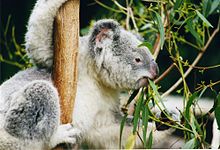

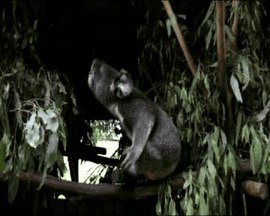
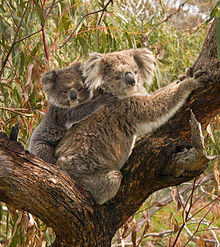

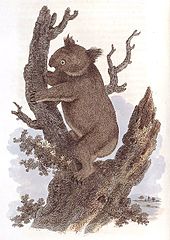
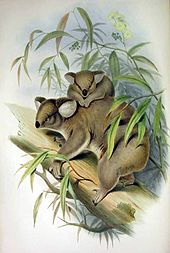


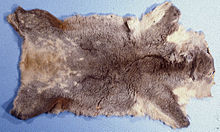

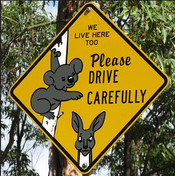
No comments:
Post a Comment
Note: Only a member of this blog may post a comment.